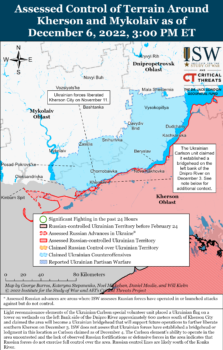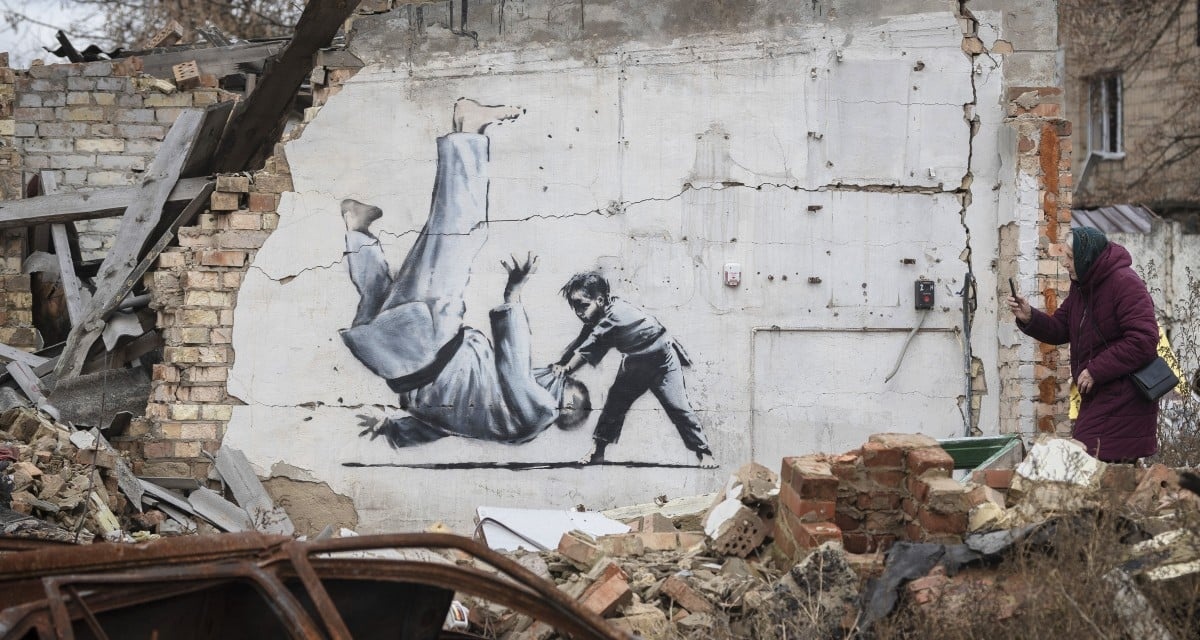A mural, possibly by the British artist Banksy, on a wall in Borodyanka near Kyiv, Ukraine. The town was liberated from Russian occupation in April. (AP)
Co-published with The Conversation:
Winter is Coming — and Ukraine is still resisting Vladimir Putin’s invasion after 9 1/2 months.
Russia had expected to be victorious conquerors long before this. Its initial plan envisaged ground assaults across Ukraine in the first 10 days, and full annexation of the country by August.
But Kyiv did not fall, and President Volodymyr Zelenskiy refused to leave the capital, saying, “I need ammunition, not a ride” as he rallied Ukrainians. Thus the first phase of Putin’s invasion ended with Russia’s withdrawal from all of northern Ukraine by April.
Moscow pursued a more limited operation in the second phase over the spring and early summer. Russian troops were successful in expanding their occupation of part of southern Ukraine, forcing the surrender of Mariupol after 12 weeks of assault and siege, and they seized all of the Luhansk region and parts of neighboring Donetsk in the east.
But the third phase from August through November has been one of a Ukrainian fightback. A lightning-quick counter-offensive liberated all of the Kharkiv region in the northeast and regained key cities in towns in Donetsk as well. In the south, the Ukrainian advance across the Kherson region culminated on November 11 with the liberation of Kherson city, seized by the Russians in the first days of their invasion.
See also EA on Australia’s ABC: The Ukraine War is Turning in Kyiv’s Favor
There is no longer the possibility of a Putin victory. His “annexation” of four Ukrainian regions, two in the south and two in the east, is in tatters. Instead, the question is how far and how fast Ukraine can regain the territory occupied in 2022, and put pressure on areas held by Russian proxies since 2014.
What then for winter’s fourth phase of the war?
The Southern Front

Institute for the Study of War
With the liberation of Kherson city, Ukrainian forces hold all areas west of the Dnipro River. The retreating Russian forces are on the east bank, having blown up all major bridges to prevent Ukrainian pursuit.
But there are gathering signs of another Ukrainian push. The first troops crossed the Dnipro and established a foothold in a village last week. The Russians are moving civilians out of some settlements on the east bank, and have reportedly withdrawn some troops as well. It is still unclear where they will establish their new defensive line.
Kh
The Ukrainian pattern through the autumn has been to degrade Russian capabilities, through strikes on occupied Crimea as well as eastern Kherson, before advancing on the ground. The strikes have damaged or destroyed bases, warplanes, ammunition depots, bridges, and logistics and supply positions.
That is likely to be the pattern through the winter as well.
The Eastern Front

Institute for the Study of War
The rapid Ukraine advance in September has been followed by consolidation of the liberated positions in key cities such as Izyum and Lyman. Russia has tried to disrupt this with persistent shelling.
The Russians have also sought for weeks to declare a largely-symbolic victory with the conquest of Bakhmut in the Donetsk region. The fighting has been some of the bloodiest in the war, but a Russian victory would have little strategic value — Bakhmut’s role as the southern end of Ukraine’s defensive line was overtaken by the autumn counter-offensive.
More important is whether Ukraine can break through the Russian lines in the direction of Svatove and Kreminna in the Luhansk region. Success would begin to roll back Russia’s summer advance, further eroding the proxy areas and Putin’s “annexation”.
Ukraine’s September success was due in part to intelligence that the Russians had left their lines thinly-defended. Ukrainian commanders say Vladimir Putin’s mass mobilization, declared September 21, has put newly-trained men on the frontline. However, they note that those men are poorly equipped — the Ukrainians will watch carefully for that, plus ongoing issues about Russian command, to provide another opportunity for liberation.
Putin’s Energy Front in Ukraine
Vladimir Putin’s last hope of regaining the initiative is to break Ukraine’s energy infrastructure. Russia has escalated strikes on civilian sites across the country since October 10.
The assaults, sometimes with more than 100 missiles as well as Iranian-supplied attack drones, have knocked out up to half of Ukraine’s power grid. But Ukrainian will has not broken amid round-the-clock repairs and emergency and scheduled blackouts.
Instead, the latest Russian strike on December 5 shows diminished capability. Just over 70 missiles were launched, and more than 60 were downed by Ukrainian air defenses. Western officials say the Iranian drones have been exhausted, and Tehran has not agreed to a further delivery. Nor has a deal been completed for Iran’s ballistic missiles, and Russia has a stock sufficient for only two or three more mass attacks, according to Ukraine Presidential advisor Mykhailo Podolyak.
See also Ukraine War, Day 286: Russia’s Missile Attack is Blunted…and Its Airfields Are Struck
Putin’s Energy Front Beyond Ukraine
The Kremlin attempted through the summer and autumn to break European support for Kyiv with the threat of a reduction, or even a complete halt, of energy supplies. The Russians used the pretext of technical issues to shut down the Nord Stream 1 gas pipeline to Germany, and are suspected of explosions damaging both Nord Stream 1 and 2 in the Baltic Sea.
But Putin failed with his “food war” this summer, having to lift the Russian blockade on Ukraine’s Black Sea grain exports, and his energy war did not reduce Europe’s assistance for Ukraine.
To the contrary, European countries — individually and through the European Union — stepped up financial and military assistance. They implemented programs for energy conservation, sourced alternative supplies, and constructed floating terminals for natural gas. In Germany, once dependent on Russia’s for 55% of its gas, consumption has been reduced 25%-30% and gas storage facilities are almost 98% full. Similar figures are reported for France, Italy, and the Netherlands.
The War Crimes Front
On the diplomatic front, there is no prospect of negotiations. Ukraine’s precondition is Russian withdrawal from territory occupied this year. Putin shows no sign of giving up on his ambition for the eventual fall of the Zelenskiy Government and retention of his “annexations”.
The focus has shifted to justice and accountability for war crimes committed by Russian forces during the conflict. The UN and the International Criminal Court are already carrying out investigations, gathering evidence and collecting witness statements from liberated areas.
Even more significantly, there is now a sustained effort for Russian leaders as well as individual troops to face prosecution. Ukraine President Volodymyr Zelenskiy’s call for an international tribunal is now being supported by France and the Netherlands as well as the Baltic States. European Commission Ursula von der Leyen said on November 30 that the European Union, with UN backing, will support the special court. A draft UN resolution is being prepared for consideration by the General Assembly.
See also Putin’s Ukraine War Turns Russia Into “Terrorist State”
The Russian Front
Meanwhile, Putin faces pressure on multiple domestic fronts.
The Russian economy, now on a wartime footing, is projected to contract by 8% over 2022-2023. Much of the manufacturing sector, such as the automotive industry, is crippled. Russia’s oil revenue is falling, even before this week’s imposition of a price cap by the European Union, G7 countries, and Australia.
The Kremlin has cracked down on dissent with detentions and the threat of lengthy prison sentences, but Putin’s mass mobilization and the Ukrainian advances are spurring discontent within his own ranks as well as the Russian public.
In a November poll by the independent Levada Center, 53% of respondents favor negotiations v. 41% who want to press ahead with the troubled invasion.
An internal Kremlin-commissioned poll was even starker for Putin: 55% favored peace talks and only 25% wanted a continuation of the war.
Winter is Coming, and it’s cold across Ukraine.
But the chilly winds of defeat? Those are blowing through Moscow’s Red Square.

